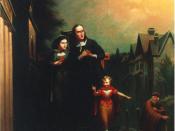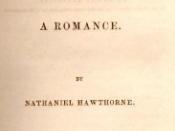The adulteress, Hester Prynne, shows a combination of an unrelenting sinner and sainthood, but which one prevails; or do they coexist? In Nathaniel Hawthorne's The Scarlet Letter, Hester commits adultery with the town minister and bears a daughter along with the scarlet A on her bosom so everyone can see her sin and shame. Hester undergoes a dramatic change throughout the seven years the book takes place in Boston during the Puritan settlement days, in which she seems to do and think the unthinkable things, but then reflects an inner goodness. Which is her true self?
In the first chapter of the book, Hester is depicted as a sinning hussy who deserves to get a worse punishment than wearing the A. The town wives believe her punishment should have been at the least a brand on her forehead, and one even says that Hester should get the death penalty.
Later in the book, she has the audacity to question the entire Puritan belief system. Hester committed a mortal sin through adultery and she also questioned her belief in the Puritan God. Those are appalling acts that a sinner would do.
As the story continues, Hester begins to act differently. Her daughter, Pearl, keeps Hester from acting out against society and their beliefs. Hester also perceives her affair as an act of love, and therefore, does not see it as a sin. In her own words: "What we did had a consecration of its own." Hester is saying that their affair was not a sin but a sacred event that was meant to be done. Even the townspeople forget what the scarlet letter truly stands for and rename it A for Able. Hester becomes known for her helpfulness and she takes the best care of Pearl that she can...


